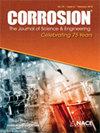循环时效试验中有机涂层碳钢丝状腐蚀的发生
IF 1.3
4区 材料科学
Q4 MATERIALS SCIENCE, MULTIDISCIPLINARY
引用次数: 0
摘要
丝状腐蚀是有机涂层钢可能的失效机制之一。除阴极脱层外,丝状腐蚀还会导致涂料脱离,并使所涂涂料的保护性能急剧下降。由于这两种失效机制都发生在现场暴露过程中(取决于环境),因此在通过实验室规模试验评估防护漆的性能时,我们必须了解不同加速老化柜诱导的失效机制。在本研究中,我们研究了预腐蚀试验对丝状腐蚀的产生和扩展的影响。我们强调了丝状腐蚀和阴极起泡的同时发展,其中包括在饱和湿度和干燥阶段之间循环的加速老化过程中阴极和阳极分层前沿之间的变化。讨论了侵略性污染物(Cl−和SO42−)的存在所起的作用。根据我们的研究结果,循环老化试验似乎更好地坚持破坏机制发生在现场暴露,特别是由于湿/干循环。本文章由计算机程序翻译,如有差异,请以英文原文为准。
On the occurrence of filiform corrosion on organic coated carbon steel exposed to cyclic aging test
ABSTRACT Filiform corrosion is one of the possible failure mechanisms of organic-coated steel. Beyond cathodic delamination, filiform corrosion causes paint detachment and the dramatic loss of the protective properties given by the applied paint. Since both failure mechanisms occur during in-field exposure (depending on the environment), when assessing the performance of the protective paint by lab scale tests, we must be aware of the failure mechanism we induce with different accelerated aging cabinets. In this study, we investigate the effect of prohesion test on the initiation and propagation of filiform corrosion. We highlight the concurrent development of filiform corrosion and cathodic blistering, which includes the change between the cathodic and anodic delamination front, during an accelerated aging procedure that cycles between saturated humidity and dry stages. The role of the presence of aggressive contaminants (Cl− and SO42−) is discussed. According to our findings, cyclic aging tests seem to better stick to the failure mechanism occurring during in-field exposure, particularly due to the wet/dry cycles.
求助全文
通过发布文献求助,成功后即可免费获取论文全文。
去求助
来源期刊

Corrosion
MATERIALS SCIENCE, MULTIDISCIPLINARY-METALLURGY & METALLURGICAL ENGINEERING
CiteScore
2.80
自引率
12.50%
发文量
97
审稿时长
3 months
期刊介绍:
CORROSION is the premier research journal featuring peer-reviewed technical articles from the world’s top researchers and provides a permanent record of progress in the science and technology of corrosion prevention and control. The scope of the journal includes the latest developments in areas of corrosion metallurgy, mechanisms, predictors, cracking (sulfide stress, stress corrosion, hydrogen-induced), passivation, and CO2 corrosion.
70+ years and over 7,100 peer-reviewed articles with advances in corrosion science and engineering have been published in CORROSION. The journal publishes seven article types – original articles, invited critical reviews, technical notes, corrosion communications fast-tracked for rapid publication, special research topic issues, research letters of yearly annual conference student poster sessions, and scientific investigations of field corrosion processes. CORROSION, the Journal of Science and Engineering, serves as an important communication platform for academics, researchers, technical libraries, and universities.
Articles considered for CORROSION should have significant permanent value and should accomplish at least one of the following objectives:
• Contribute awareness of corrosion phenomena,
• Advance understanding of fundamental process, and/or
• Further the knowledge of techniques and practices used to reduce corrosion.
 求助内容:
求助内容: 应助结果提醒方式:
应助结果提醒方式:


